The Microsoft Surface Pro 4 Review: Raising The Bar
by Brett Howse on October 21, 2015 9:00 AM ESTBattery Life
One of the trade-offs that Microsoft has made with the Surface Pro 4 is a reduction in battery capacity. Ever since the first Surface Pro was launched, Microsoft has equipped it with a 42 Watt-hour battery. That is a large size for a tablet, but the Surface Pro has always been a larger than normal tablet too. With the Surface Pro 4, the battery capacity has been reduced slightly to 39 Wh. Part of this is the thinner chassis, and part of it is the new hybrid cooling which puts a copper plate over the battery. I can’t argue with the new cooling system, since it has clearly made a big difference in thermals.
To take a look at battery life, I’ve run both our tablet battery tests and our notebook battery tests. As with all of our battery life testing, the display is set to 200 nits for a consistent result across devices.
Tablet Battery Life
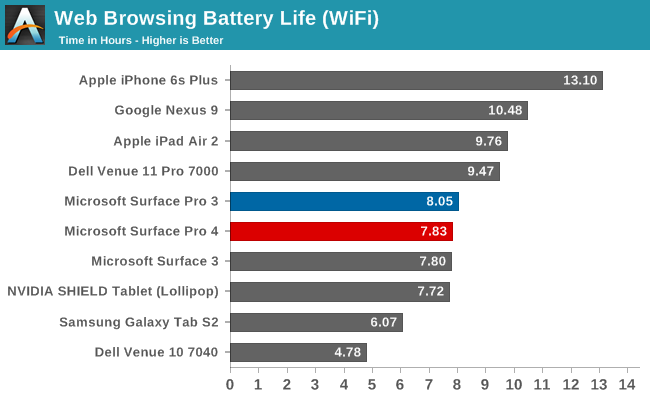
Looking at our tablet web browsing test, the Surface Pro 4 comes in right around the same battery life of the Surface Pro 3, running out of power about 13 minutes sooner. When you think about the move to Skylake, this could be taken as a disappointment, and I honestly thought it might be able to get a bit more. But the smaller battery capacity and increased pixel density both negatively impact batter life despite the CPU using a bit less power itself. I would have loved to see the larger battery stay, which would have given it about 8.5 hours, but the improved cooling system is likely a better trade-off compared to around 30 minutes of battery life.
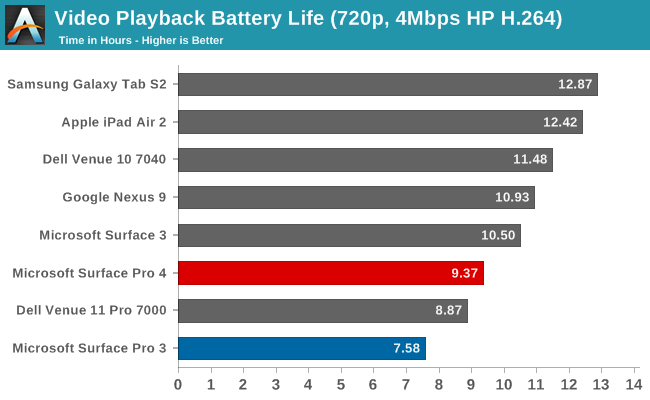
Once we shift to a more CPU-intensive workload however we start seeing significant gains. Intel has been making good progress on their video decode power consumption since Haswell, and the Surface Pro 4, despite the greater pixel density and a smaller battery, achieves 23% longer battery life than the Surface Pro 3 at this task. This is a great result and puts the Surface Pro 4 more in line with what traditional ARM based tablets can achieve.
Notebook Battery Life
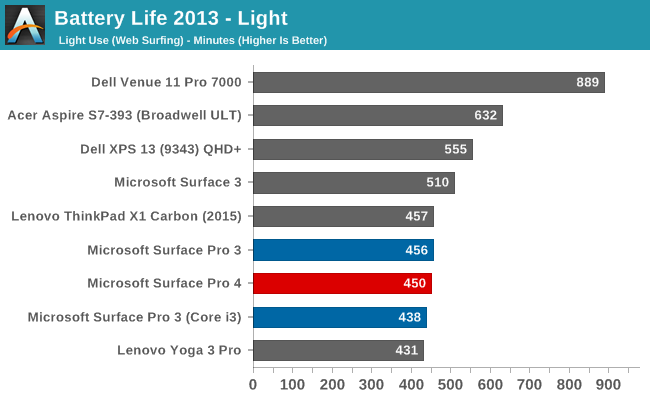
Once again the Surface Pro 4 falls right in line with the previous generations for battery life, which means that the efficiency has been improved even though the panel is much denser. While certainly not class leading in overall life, for the size of device and performance available, it is a pretty good result. Being able to keep battery life flat, while improving the display resolution, and making the device thinner and lighter, is in line with what you would expect as they pack more and more power efficient parts into the Surface Pro 4.
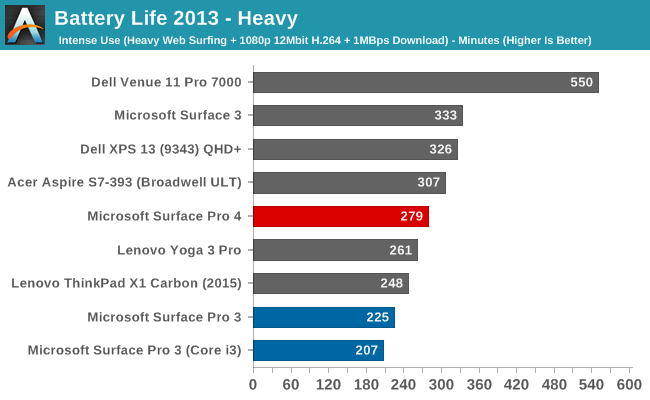
Under our heavy battery life test we can really see the improvements with Skylake. The Surface Pro 4 battery life score on our heavy battery life test outlasts the Surface Pro 3 by 21%. The heavy test involves video playback, which we have just seen in the tablet workload is significantly improved, as well as a much higher web load and a 1 MB/s file download. Once again, the Surface Pro 4 is not going to be able to compete with notebooks with much larger batteries, but for the size and weight of the device, it is a good result.
Next up let’s break down our results by energy efficiency.

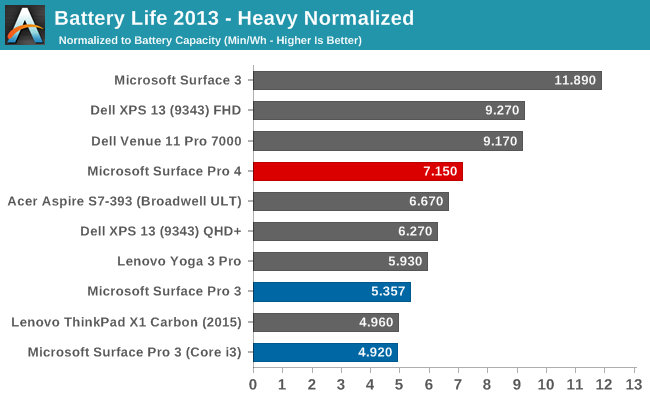
The XPS 13 is the class leader in battery life at the moment, but it achieves this with the 1920x1080 display. In order to be more comparable to the Surface Pro 4, the graph shows the higher resolution 3200x1800 version which was still able to get some pretty good battery life scores. The Surface Pro 4 manages to be more efficient than every other high resolution device we have tested, although lower resolution devices are still able to offer greater overall efficiency.
Charge Time
Microsoft has kept the same charging system from the Surface Pro 3, with the Surface Connect port providing the connection. This hasn’t changed since the last model, but I do like the magnetic connector and how well it always attaches. I kind of wish Microsoft had added a USB-C here as well, but the Surface Connect port is a pretty nice implementation. Unsurprisingly then, the charge time does not change very much at all compared to last year’s model.
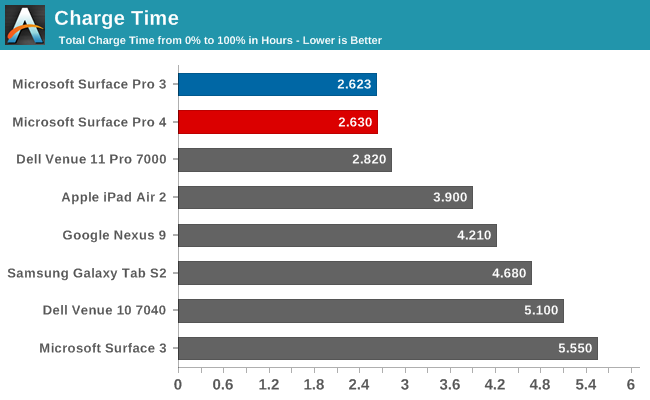
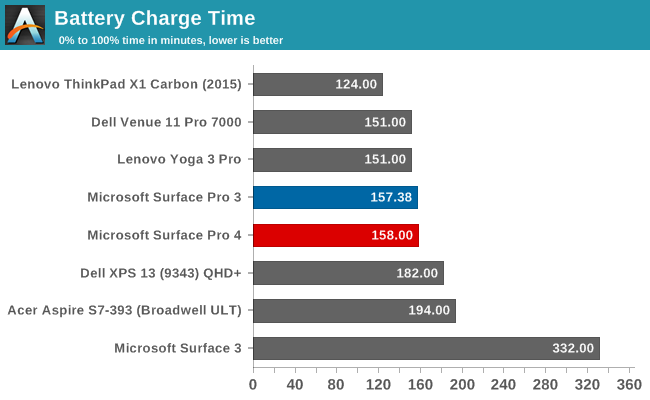
I recorded a 158-minute charge time with the standard charger. Microsoft also offers a higher wattage 60 W version for use with the Surface Book, and you can also purchase it as an accessory for the Surface Pro 4. The result with that charger? 158 minutes. The Surface Pro 4 did not dump any extra power to the battery at all with the higher wattage charger.
Once other nice part of the Surface Pro 4 charger, which also carries over, is the included 5 W USB port on the charger itself, so you can charge up your smartphone without burning two outlets. It’s a small thing, but when you are at a hotel where outlets on the desk are at a premium, it’s nice to be able to do this.


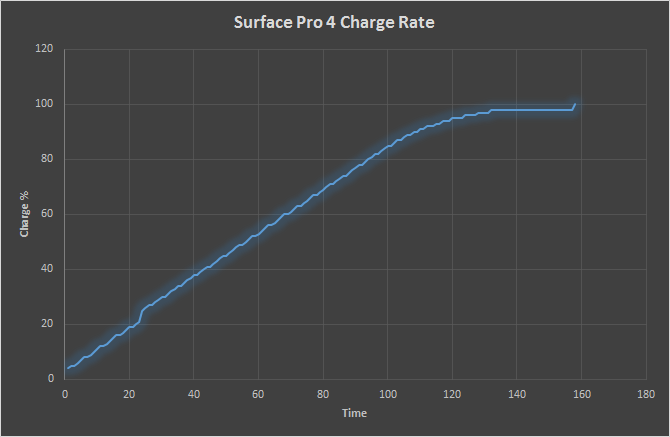








175 Comments
View All Comments
BMNify - Friday, October 23, 2015 - link
Thanks for an excellent review Brett, would be interesting to see the battery life tests with m3 version, hopefully you can get hold of it later and add the data to the table and also a pipeline post.Superlight - Friday, October 23, 2015 - link
Man ... Thanks for the PC Mag review. Anandtech has gone so far downhill :(((SaolDan - Friday, October 23, 2015 - link
Dude when i read your comment i went straight to pcmag.com. OMG what a disappointment that was. And the nonstop ads on my phone( Company issued iphone 6 which i hate btw. I was happier with my $35 lumia 635). Anandtech in my opinion is a good as it always has been. If you dont like the reviews here just go away.Klaus.88 - Friday, October 23, 2015 - link
I have to ask Anandtech: is it possible to have partial results of 3DMark benchamarks and similar? I need the graphic results.Thank you
Eleveneleven - Friday, October 23, 2015 - link
What is taking so long on the Surface Book review? Pretty much everyone else has theirs out. The Surface 4 review should have come out AFTER that. That's no where near as significant of a release.ezridah - Friday, October 23, 2015 - link
Read the beginning of the second paragraph:http://www.anandtech.com/show/9732/the-microsoft-s...
Eleveneleven - Monday, October 26, 2015 - link
So? He got that a week ago or longer. Where is his post production unit? A review should be up by now.Eleveneleven - Monday, October 26, 2015 - link
They're pretty much the only tech review site without a review on it. That looks really bad.val580 - Monday, October 26, 2015 - link
Yeah I mean I pay them a lot for Christ sake! Give my money back!IntelUser2000 - Sunday, October 25, 2015 - link
Guesses on the Core m3 and Core i7 with Iris 540:Core m3
-Performance should be quite a lot better and actually not far off from i5 SP3
-Battery life is probably similar to Core i5 versions. Ideally it should be better but lets see how good Intel does with it
-This is going to get stiff competition from the A9X chips. It'll probably get beaten in graphics but be better on CPU
Core i7 with Iris 540
-30-40% faster in graphics than Core i5 with HD 520. Closer to 30% if eDRAM affects TDP available to CPU/GPU too much, 40% if it doesn't. On the Iris Pro chips the 128MB costs them 3W, 3W is a lot for a 15W chip
-10-15% better than Core i5 CPU, with ~5% due to eDRAM
-Battery life might end up somewhat worse. eDRAM adds 0.25W power to idle power.